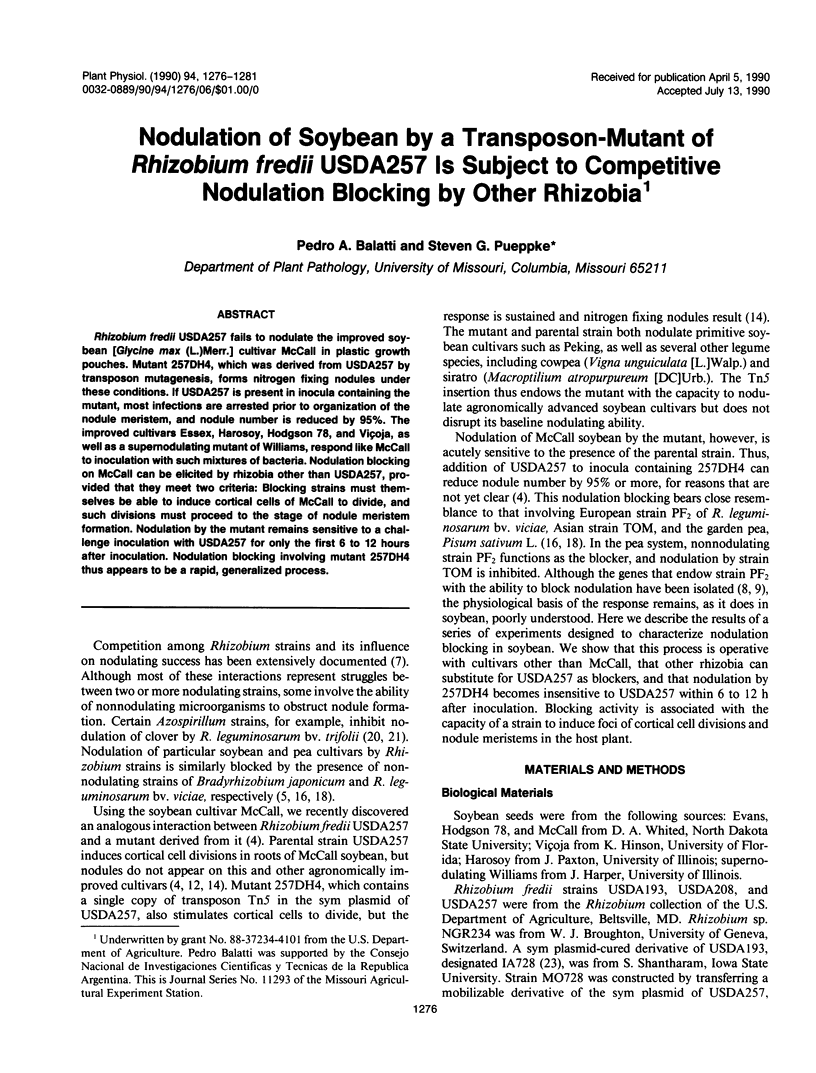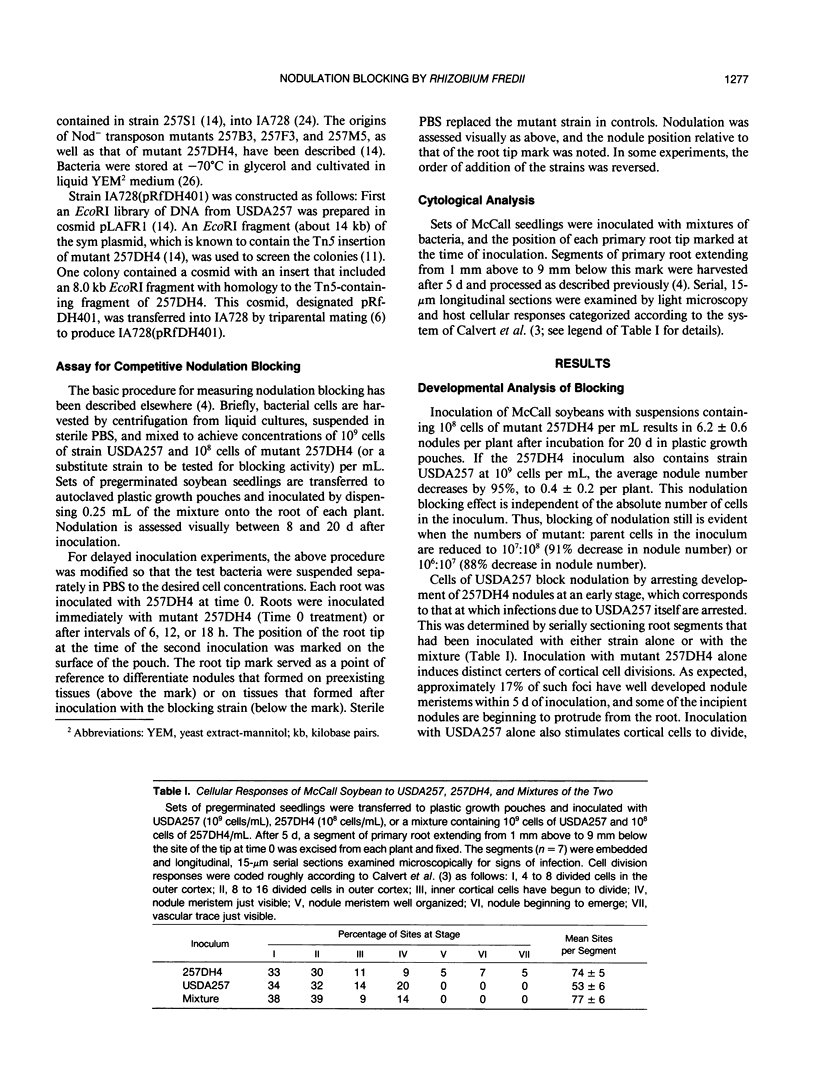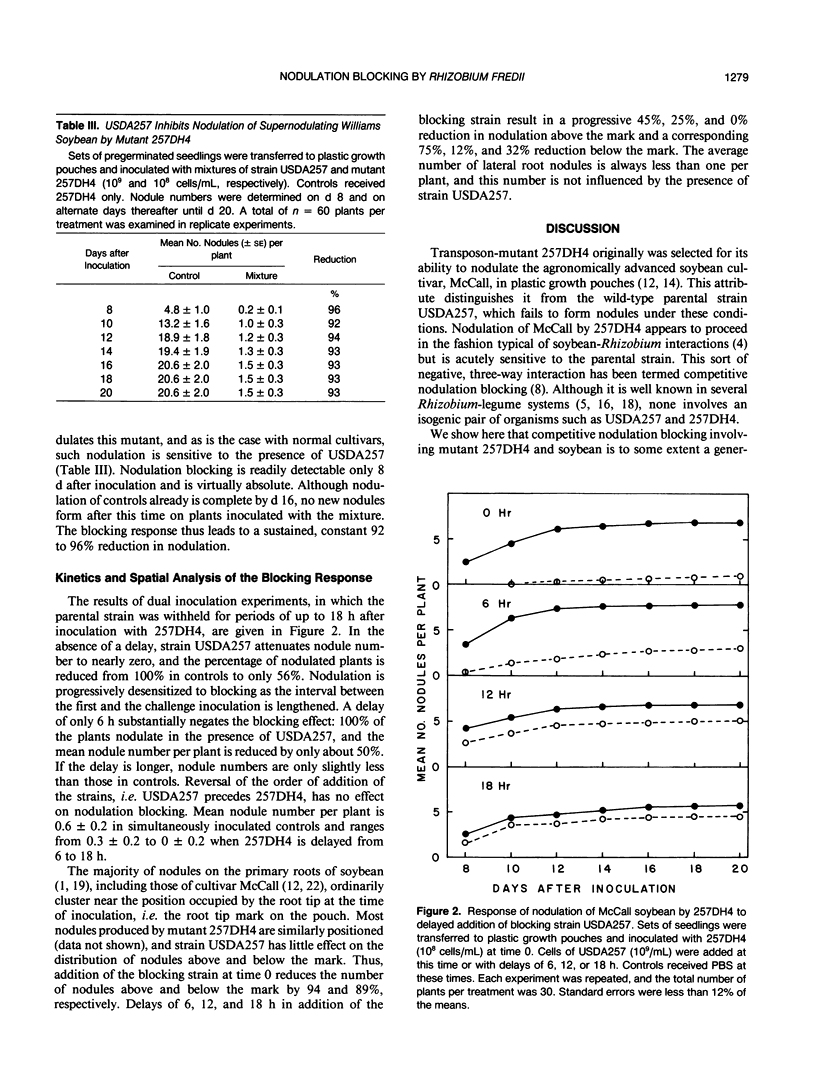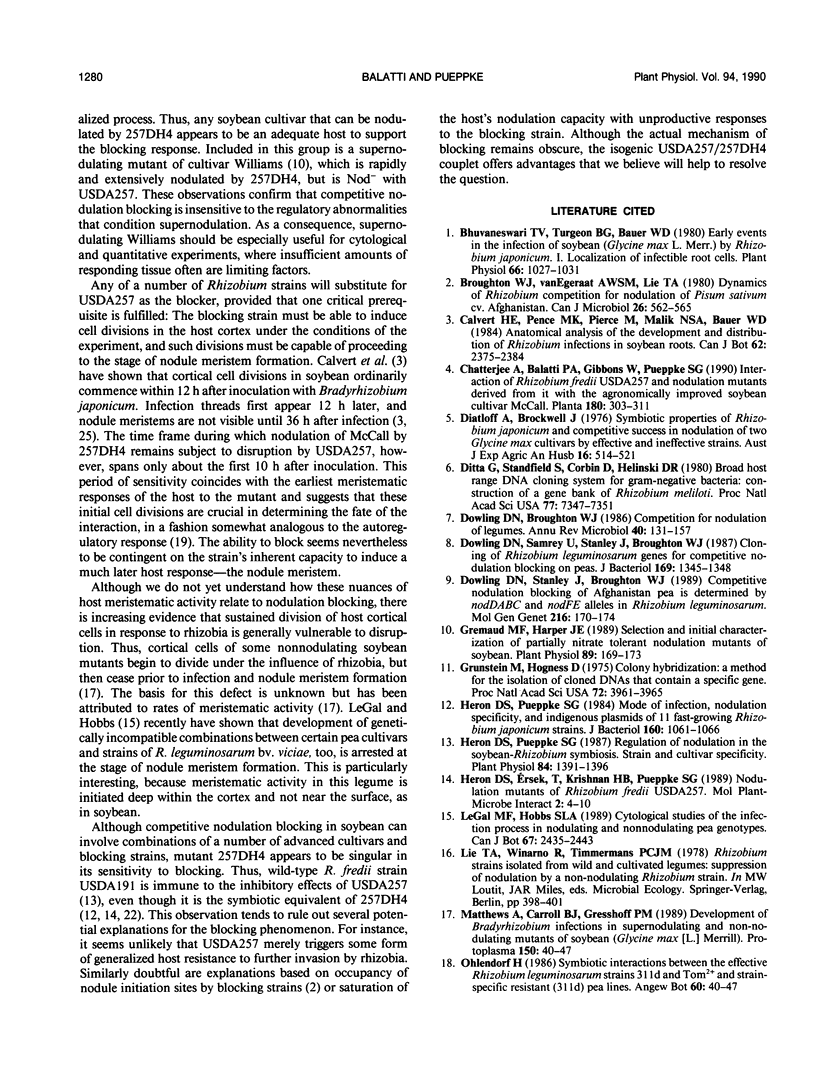Abstract
Rhizobium fredii USDA257 fails to nodulate the improved soybean [Glycine max (L.)Merr.] cultivar McCall in plastic growth pouches. Mutant 257DH4, which was derived from USDA257 by transposon mutagenesis, forms nitrogen fixing nodules under these conditions. If USDA257 is present in inocula containing the mutant, most infections are arrested prior to organization of the nodule meristem, and nodule number is reduced by 95%. The improved cultivars Essex, Harosoy, Hodgson 78, and Viçoja, as well as a supernodulating mutant of Williams, respond like McCall to inoculation with such mixtures of bacteria. Nodulation blocking on McCall can be elicited by rhizobia other than USDA257, provided that they meet two criteria: Blocking strains must themselves be able to induce cortical cells of McCall to divide, and such divisions must proceed to the stage of nodule meristem formation. Nodulation by the mutant remains sensitive to a challenge inoculation with USDA257 for only the first 6 to 12 hours after inoculation. Nodulation blocking involving mutant 257DH4 thus appears to be a rapid, generalized process.
Full text
PDF





Selected References
These references are in PubMed. This may not be the complete list of references from this article.
- Bhuvaneswari T. V., Turgeon B. G., Bauer W. D. Early Events in the Infection of Soybean (Glycine max L. Merr) by Rhizobium japonicum: I. LOCALIZATION OF INFECTIBLE ROOT CELLS. Plant Physiol. 1980 Dec;66(6):1027–1031. doi: 10.1104/pp.66.6.1027. [DOI] [PMC free article] [PubMed] [Google Scholar]
- Broughton W. J., van Egeraat A. W., Lie T. A. Dynamics of Rhizobium competition for nodulation of Pisum sativum cv. Afghanistan. Can J Microbiol. 1980 Apr;26(4):562–565. doi: 10.1139/m80-099. [DOI] [PubMed] [Google Scholar]
- Ditta G., Stanfield S., Corbin D., Helinski D. R. Broad host range DNA cloning system for gram-negative bacteria: construction of a gene bank of Rhizobium meliloti. Proc Natl Acad Sci U S A. 1980 Dec;77(12):7347–7351. doi: 10.1073/pnas.77.12.7347. [DOI] [PMC free article] [PubMed] [Google Scholar]
- Dowling D. N., Broughton W. J. Competition for nodulation of legumes. Annu Rev Microbiol. 1986;40:131–157. doi: 10.1146/annurev.mi.40.100186.001023. [DOI] [PubMed] [Google Scholar]
- Dowling D. N., Samrey U., Stanley J., Broughton W. J. Cloning of Rhizobium leguminosarum genes for competitive nodulation blocking on peas. J Bacteriol. 1987 Mar;169(3):1345–1348. doi: 10.1128/jb.169.3.1345-1348.1987. [DOI] [PMC free article] [PubMed] [Google Scholar]
- Gremaud M. F., Harper J. E. Selection and initial characterization of partially nitrate tolerant nodulation mutants of soybean. Plant Physiol. 1989 Jan;89(1):169–173. doi: 10.1104/pp.89.1.169. [DOI] [PMC free article] [PubMed] [Google Scholar]
- Grunstein M., Hogness D. S. Colony hybridization: a method for the isolation of cloned DNAs that contain a specific gene. Proc Natl Acad Sci U S A. 1975 Oct;72(10):3961–3965. doi: 10.1073/pnas.72.10.3961. [DOI] [PMC free article] [PubMed] [Google Scholar]
- Heron D. S., Pueppke S. G. Mode of infection, nodulation specificity, and indigenous plasmids of 11 fast-growing Rhizobium japonicum strains. J Bacteriol. 1984 Dec;160(3):1061–1066. doi: 10.1128/jb.160.3.1061-1066.1984. [DOI] [PMC free article] [PubMed] [Google Scholar]
- Heron D. S., Pueppke S. G. Regulation of nodulation in the soybean-Rhizobium symbiosis : strain and cultivar variability. Plant Physiol. 1987 Aug;84(4):1391–1396. doi: 10.1104/pp.84.4.1391. [DOI] [PMC free article] [PubMed] [Google Scholar]
- Pierce M., Bauer W. D. A rapid regulatory response governing nodulation in soybean. Plant Physiol. 1983 Oct;73(2):286–290. doi: 10.1104/pp.73.2.286. [DOI] [PMC free article] [PubMed] [Google Scholar]
- Plazinski J., Rolfe B. G. Influence of azospirillum strains on the nodulation of clovers by Rhizobium strains. Appl Environ Microbiol. 1985 Apr;49(4):984–989. doi: 10.1128/aem.49.4.984-989.1985. [DOI] [PMC free article] [PubMed] [Google Scholar]
- Plazinski J., Rolfe B. G. Interaction of azospirillum and Rhizobium strains leading to inhibition of nodulation. Appl Environ Microbiol. 1985 Apr;49(4):990–993. doi: 10.1128/aem.49.4.990-993.1985. [DOI] [PMC free article] [PubMed] [Google Scholar]
- Ramakrishnan N., Prakash R. K., Shantharam S., Duteau N. M., Atherly A. G. Molecular cloning and expression of Rhizobium fredii USDA 193 nodulation genes: extension of host range for nodulation. J Bacteriol. 1986 Dec;168(3):1087–1095. doi: 10.1128/jb.168.3.1087-1095.1986. [DOI] [PMC free article] [PubMed] [Google Scholar]


